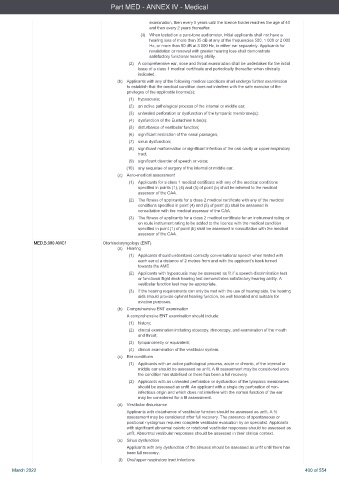Page 400 - UK AirCrew Regulations (Consolidated) March 2022
P. 400
Part MED - ANNEX IV - Medical
examination, then every 5 years until the licence holder reaches the age of 40
and then every 2 years thereafter.
(ii) When tested on a pure-tone audiometer, initial applicants shall not have a
hearing loss of more than 35 dB at any of the frequencies 500, 1 000 or 2 000
Hz, or more than 50 dB at 3 000 Hz, in either ear separately. Applicants for
revalidation or renewal with greater hearing loss shall demonstrate
satisfactory functional hearing ability.
(2) A comprehensive ear, nose and throat examination shall be undertaken for the initial
issue of a class 1 medical certificate and periodically thereafter when clinically
indicated.
(b) Applicants with any of the following medical conditions shall undergo further examination
to establish that the medical condition does not interfere with the safe exercise of the
privileges of the applicable licence(s):
(1) hypoacusis;
(2) an active pathological process of the internal or middle ear;
(3) unhealed perforation or dysfunction of the tympanic membrane(s);
(4) dysfunction of the Eustachian tube(s);
(5) disturbance of vestibular function;
(6) significant restriction of the nasal passages;
(7) sinus dysfunction;
(8) significant malformation or significant infection of the oral cavity or upper respiratory
tract;
(9) significant disorder of speech or voice;
(10) any sequelae of surgery of the internal or middle ear.
(c) Aero-medical assessment
(1) Applicants for a class 1 medical certificate with any of the medical conditions
specified in points (1), (4) and (5) of point (b) shall be referred to the medical
assessor of the CAA.
(2) The fitness of applicants for a class 2 medical certificate with any of the medical
conditions specified in point (4) and (5) of point (b) shall be assessed in
consultation with the medical assessor of the CAA.
(3) The fitness of applicants for a class 2 medical certificate for an instrument rating or
en route instrument rating to be added to the licence with the medical condition
specified in point (1) of point (b) shall be assessed in consultation with the medical
assessor of the CAA.
MED.B.080 AMC1 Otorhinolaryngology (ENT)
(a) Hearing
(1) Applicants should understand correctly conversational speech when tested with
each ear at a distance of 2 metres from and with the applicant’s back turned
towards the AME.
(2) Applicants with hypoacusis may be assessed as fit if a speech discrimination test
or functional flight deck hearing test demonstrates satisfactory hearing ability. A
vestibular function test may be appropriate.
(3) If the hearing requirements can only be met with the use of hearing aids, the hearing
aids should provide optimal hearing function, be well tolerated and suitable for
aviation purposes.
(b) Comprehensive ENT examination
A comprehensive ENT examination should include:
(1) history;
(2) clinical examination including otoscopy, rhinoscopy, and examination of the mouth
and throat;
(3) tympanometry or equivalent;
(4) clinical examination of the vestibular system.
(c) Ear conditions
(1) Applicants with an active pathological process, acute or chronic, of the internal or
middle ear should be assessed as unfit. A fit assessment may be considered once
the condition has stabilised or there has been a full recovery.
(2) Applicants with an unhealed perforation or dysfunction of the tympanic membranes
should be assessed as unfit. An applicant with a single dry perforation of non-
infectious origin and which does not interfere with the normal function of the ear
may be considered for a fit assessment.
(d) Vestibular disturbance
Applicants with disturbance of vestibular function should be assessed as unfit. A fit
assessment may be considered after full recovery. The presence of spontaneous or
positional nystagmus requires complete vestibular evaluation by an specialist. Applicants
with significant abnormal caloric or rotational vestibular responses should be assessed as
unfit. Abnormal vestibular responses should be assessed in their clinical context.
(e) Sinus dysfunction
Applicants with any dysfunction of the sinuses should be assessed as unfit until there has
been full recovery.
(f) Oral/upper respiratory tract infections
March 2022 400 of 554

